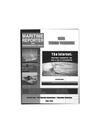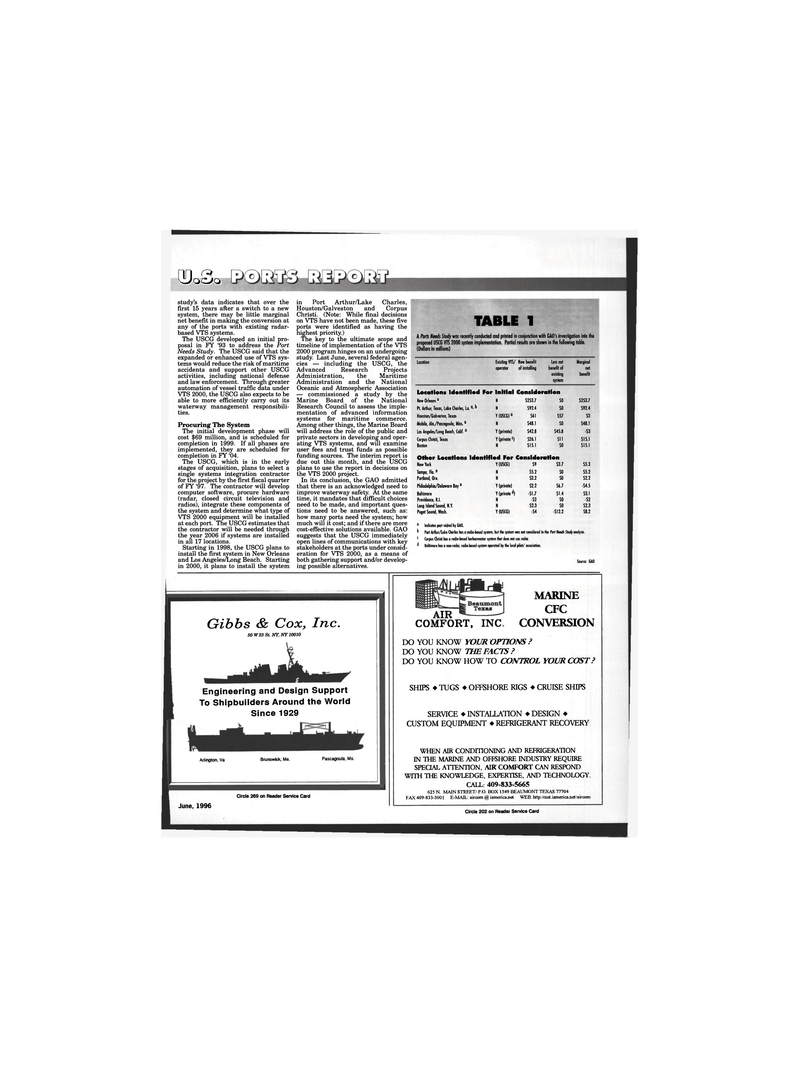
Page 137: of Maritime Reporter Magazine (June 1996)
Read this page in Pdf, Flash or Html5 edition of June 1996 Maritime Reporter Magazine
(D ^ oao study's data indicates that over the first 15 years after a switch to a new system, there may be little marginal net benefit in making the conversion at any of the ports with existing radar- based VTS systems.
The USCG developed an initial pro- posal in FY '93 to address the Port
Needs Study. The USCG said that the expanded or enhanced use of VTS sys- tems would reduce the risk of maritime accidents and support other USCG activities, including national defense and law enforcement. Through greater automation of vessel traffic data under
VTS 2000, the USCG also expects to be able to more efficiently carry out its waterway management responsibili- ties.
Procuring The System
The initial development phase will cost $69 million, and is scheduled for completion in 1999. If all phases are implemented, they are scheduled for completion in FY '04.
The USCG, which is in the early stages of acquisition, plans to select a single systems integration contractor for the project by the first fiscal quarter of FY '97. The contractor will develop computer software, procure hardware (radar, closed circuit television and radios), integrate these components of the system and determine what type of
VTS 2000 equipment will be installed at each port. The USCG estimates that the contractor will be needed through the year 2006 if systems are installed in all 17 locations.
Starting in 1998, the USCG plans to install the first system in New Orleans and Los Angeles/Long Beach. Starting in 2000, it plans to install the system in Port Arthur/Lake Charles,
Houston/Galveston and Corpus
Christi. (Note: While final decisions on VTS have not been made, these five ports were identified as having the highest priority.)
The key to the ultimate scope and timeline of implementation of the VTS 2000 program hinges on an undergoing study. Last June, several federal agen- cies — including the USCG, the
Advanced Research Projects
Administration, the Maritime
Administration and the National
Oceanic and Atmospheric Association — commissioned a study by the
Marine Board of the National
Research Council to assess the imple- mentation of advanced information systems for maritime commerce.
Among other things, the Marine Board will address the role of the public and private sectors in developing and oper- ating VTS systems, and will examine user fees and trust funds as possible funding sources. The interim report is due out this month, and the USCG plans to use the report in decisions on the VTS 2000 project.
In its conclusion, the GAO admitted that there is an acknowledged need to improve waterway safety. At the same time, it mandates that difficult choices need to be made, and important ques- tions need to be answered, such as: how many ports need the system; how much will it cost; and if there are more cost-effective solutions available. GAO suggests that the USCG immediately open lines of communications with key stakeholders at the ports under consid- eration for VTS 2000, as a means of both gathering support and/or develop- ing possible alternatives.
TABLE 1
A Ports Needs Study was recently conducted and printed in conjunction with GAO's investigation into the proposed USCG VTS 2000 system implementation. Partial results are shown in the following table. (Dollars in millions)
Location Existing VIS/ New benefit operator of installing
Less net benefit of existing system
Marginal net benefit
Locations Identified For Initial Consideration
New Orleans11 N $253.7 $0 $253.7
Ft. Arthur, Texas, Lake Charles, La. a< b N $92.4 $0 $92.4
Houston/Galveston, Texas Y(USCG)0 $61 $57 $3
Mobile, Ala./Pascagoula, Miss.a N $48.1 $0 $48.1
Los Angeles/Long Beach, Calif.0 Y (private) $42.8 $45.8 -S3
Corpus Christi, Texas Y (privatec) $26.1 $11 $15.1
Boston N $15.1 $0 $15.1
Other Locations Identified For Consideration
New York Y(USCG) $9 $3.7 $5.3
Tampa, Fla.0 N $5.2 $0 $5.2
Portland, Ore. N $2.2 $0 $2.2
Philadelphia/Delaware Bay G Y (private) $2.2 $6.7 -$4.5
Baltimore Y (private J) -$1.7 $1.4 $3.1
Providence, R.I. N -$2 $0 -$2
Long Island Sound, N.Y. N $2.3 $0 $2.3
Puget Sound, Wash. Y(USCG) -$4 -$12.2 $8.2 11 Indicates port visited by GAO. ^ Port Arthur/Lake Charles has a radio-based system, but the system was not considered in the Port Heeds Study analysis. c Corpus Christi has a radio-based harbormaster system that does not use radar, d Baltimore has a non-radar, radio-based system operated by the local pilots' association.
Source: GAO
Gibbs & Cox, Inc. 50 W 23 St. NY, NY 10010
Engineering and Design Support
To Shipbuilders Around the World
Since 1929
Arlington, Va Brunswick, Me. Pascagoula, Ms.
Circle 269 on Reader Service Card
June, 1996
AIR COMFORT, INC.
MARINE
CFC
CONVERSION
DO YOU KNOW YOUR OPTIONS ?
DO YOU KNOW THE FACTS?
DO YOU KNOW HOW TO CONTROL YOUR COST?
SHIPS • TUGS • OFFSHORE RIGS • CRUISE SHIPS
SERVICE • INSTALLATION • DESIGN •
CUSTOM EQUIPMENT • REFRIGERANT RECOVERY
WHEN AIR CONDITIONING AND REFRIGERATION
IN THE MARINE AND OFFSHORE INDUSTRY REQUIRE
SPECIAL ATTENTION, AIR COMFORT CAN RESPOND
WITH THE KNOWLEDGE, EXPERTISE, AND TECHNOLOGY.
CALL: 409-833-5665 625 N. MAIN STREET/ P.O. BOX 1549 BEAUMONT TEXAS 77704
FAX 409-833-3001 E-MAIL: aircom @ iamerica.net WEB: http:/cust.iamerica.net/aircom
Circle 202 on Reader Service Card

 136
136

 138
138
